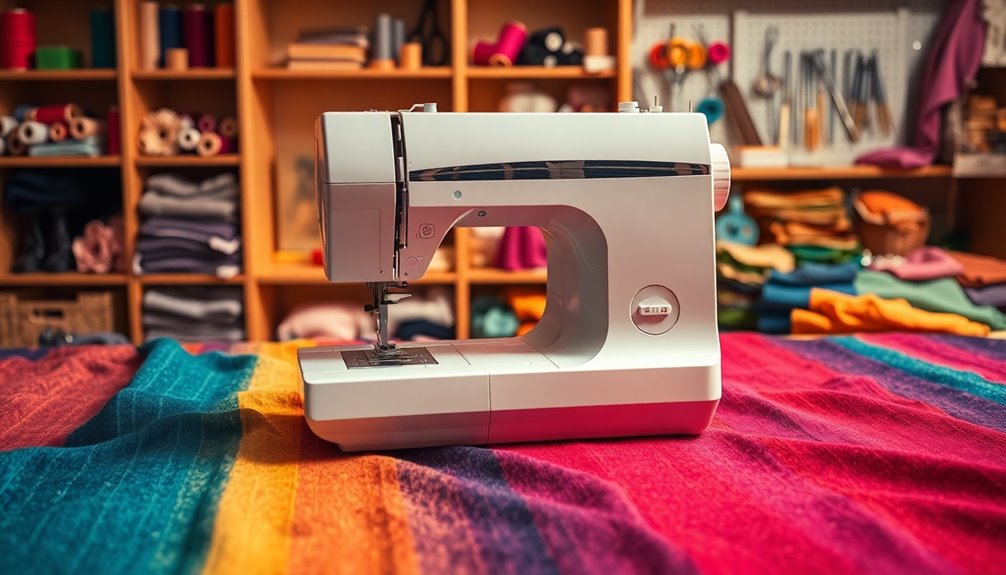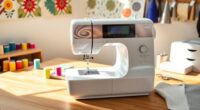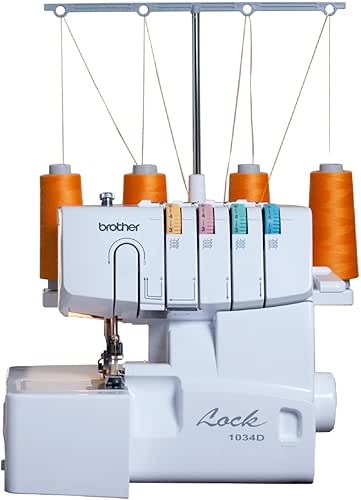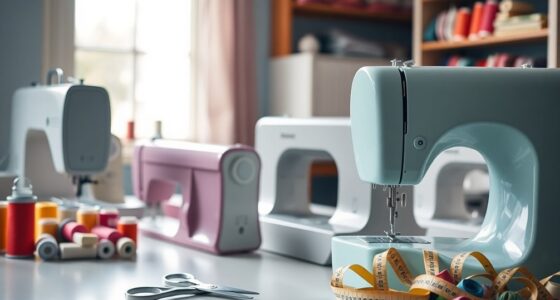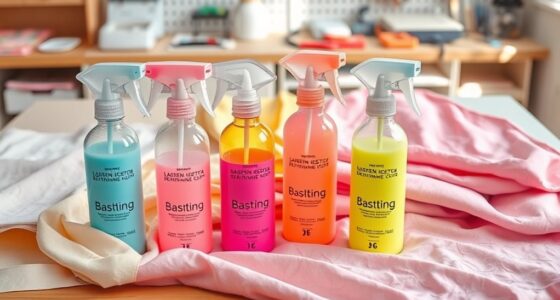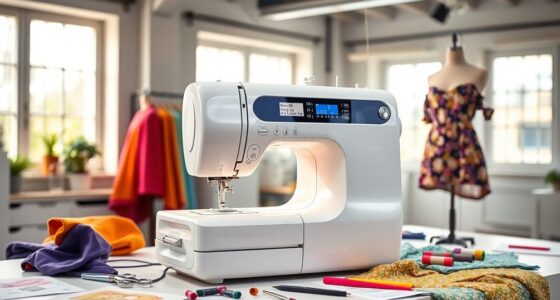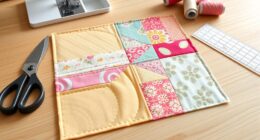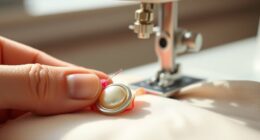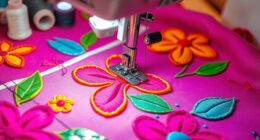If you’re looking for the best serger sewing machines for home finishing, I’ve got you covered! Machines like the Brother 1034D and SINGER X5004-HD offer speed and durability, while the FEIYUE FY505 delivers easy threading. Each machine has unique features catering to various projects, from heavy fabrics to intricate details. As you explore my list, you’ll discover which serger can help you achieve seam perfection effortlessly! When considering the best sergers for home sewing, it’s essential to evaluate your specific needs, such as the types of fabrics you’ll be working with and your sewing experience. Additionally, features like differential feed and adjustable stitch width can greatly enhance your sewing projects. With the right serger, you can enhance your creativity and easily bring your visions to life!
Key Takeaways
- Consider machines with 2/3/4 thread capabilities, like the Brother 1034D, for versatile home finishing options.
- Look for user-friendly features, such as color-coded threading guides, to simplify setup and operation.
- Evaluate durability and build quality; metal frames, like those in Brother 1034DX, enhance stability and longevity.
- Ensure the machine has multiple stitch options and fabric compatibility for tackling various sewing projects efficiently.
- Review pros and cons of each machine, such as ease of threading and noise levels, to find the best fit for your needs.
FEIYUE FY505 Serger Overlock Machine
If you're looking for a reliable and versatile serger sewing machine, the FEIYUE FY505 is an excellent choice, especially for both beginners and seasoned sewists. This machine boasts 2/3/4 thread capability, allowing for various stitch patterns. I love the built-in rolled hem feature and the adjustable differential feed for perfect fabric handling. With a sewing speed of up to 1,100 stitches per minute, it really gets the job done quickly. Its compact design fits nicely in my workspace, and the color-coded threading guides make setup a breeze. Overall, it's a fantastic blend of performance and ease of use for every sewing project.
Best For: This machine is best for both beginner and experienced sewists looking for a versatile and efficient serger for various sewing projects.
Pros:
- Easy to thread with color-coded guides and numbered loopers.
- Compact design suitable for small workspaces.
- High sewing speed of up to 1,100 stitches per minute for quick projects.
Cons:
- Some users reported issues with threading and fabric compatibility, especially with heavier materials.
- Occasional thread breaking and temperamental behavior noted by users.
- Challenges in removing and reattaching the table for cleaning.
Brother 1034D Heavy-Duty Overlock Machine
The Brother 1034D Heavy-Duty Overlock Machine is an excellent choice for anyone looking to tackle a variety of fabric projects at home, especially beginners. With a durable metal frame and the ability to stitch at 1,300 stitches per minute, it handles multiple layers, including denim, effortlessly. I love the easy threading system with color-coded guides, making setup a breeze. Plus, it comes with three accessory feet for different techniques. After years of use, I've found it reliable and user-friendly, providing great value without breaking the bank. Don't forget to experiment with settings to find what works best for your projects!
Best For: Beginners and hobbyists looking for an affordable yet reliable overlock machine to handle various fabric projects at home.
Pros:
- Durable metal frame ensures longevity and stability during operation.
- Easy threading system with color-coded guides simplifies setup for users of all skill levels.
- Versatile accessory feet allow for various sewing techniques, enhancing creativity in projects.
Cons:
- Initial threading may be confusing for complete novices despite color coding.
- Limited warranty coverage if used outside the specified 120 volts in the US.
- May require experimentation with settings to achieve desired results on different fabrics.
FEIYUE FY505 Serger Overlock Machine
For anyone looking to elevate their sewing game, the FEIYUE FY505 Serger Overlock Machine stands out with its impressive 1,100 stitches per minute speed. I love its 2/3/4 thread capability, which gives me versatility across various fabrics. The built-in rolled hem feature is a huge time-saver, and I appreciate the adjustable differential feed for smooth results. Weighing just 13.57 pounds, it's compact enough for my smaller workspace. While threading can be tricky with heavier materials, the color-coded guides help a lot. Overall, this machine offers fantastic value, especially for those who want to tackle basic tailoring projects effortlessly.
Best For: The FEIYUE FY505 Serger Overlock Machine is best for both beginner and experienced sewers looking for a versatile and efficient machine for various fabric types.
Pros:
- Versatile sewing options with 2/3/4 thread capability suitable for different fabrics.
- High-speed performance at 1,100 stitches per minute, making sewing projects quicker.
- Compact design that fits well in smaller workspaces while maintaining durability.
Cons:
- Threading can be challenging with heavier fabrics, leading to potential frustrations.
- Some users report issues with thread breaking and the machine's temperamental behavior.
- Difficulties with maintenance, particularly in removing and reattaching the table for cleaning.
American Home Serger Sewing Machine (AH100)
Looking for a versatile and user-friendly serger? The American Home Serger Sewing Machine (AH100) might be just what you need. Weighing only 14.6 pounds, this portable machine offers 4, 3, and 2-thread serging capabilities. I love the easy-to-follow color-coded threading system, which makes setup a breeze, especially for beginners. The differential feed lets me adjust fabric fullness, while the adjustable stitch length and width provide versatility. Plus, the included accessory kit is a great bonus. Although some users mention initial challenges with tight spaces, the overall stitch quality and performance leave me satisfied.
Best For: Beginners and hobbyists looking for a user-friendly and portable serger sewing machine with versatile threading options.
Pros:
- Easy to use: The color-coded threading system simplifies setup, making it beginner-friendly.
- Versatile stitching options: Capable of 4, 3, and 2-thread serging, along with adjustable stitch length and width.
- Lightweight and portable: Weighing only 14.6 pounds, it's easy to transport and store.
Cons:
- Initial challenges: Some users report difficulties with tight spaces when changing plates or needles.
- Noise level: A few users have commented on the machine being noisier than expected.
- Lack of built-in thread cutter: The absence of this feature may require additional tools for some users.
SINGER X5004-HD Metal Frame Serger & Overlock Machine
Crafted with a heavy-duty metal frame, the SINGER X5004-HD Metal Frame Serger & Overlock Machine stands out as an ideal choice for those who tackle a variety of sewing projects, especially those involving thicker fabrics. With up to 1,300 stitches per minute, it efficiently handles large projects. I love the flexibility of its 2-3-4 thread options and eight built-in stitches, perfect for durable seams and edge finishing. The larger cutting knife makes slicing through heavy materials a breeze. Though threading can be tricky at first, the online resources are a lifesaver. It's a dependable machine that delivers exceptional results!
Best For: Those who frequently sew heavy fabrics and require a reliable machine for versatile stitching options.
Pros:
- Heavy-duty metal frame ensures durability and stability for consistent stitching.
- High-speed capability of up to 1,300 stitches per minute is ideal for completing large projects quickly.
- Versatile stitching options with 2-3-4 thread capability and eight built-in stitches cater to various sewing needs.
Cons:
- Threading can be complicated for beginners, requiring time to learn.
- Some users report initial confusion with the setup, necessitating reliance on online resources.
- Weight of 15.62 pounds may make it less portable compared to lighter machines.
SINGER S14-78 Serger Overlock Machine with Accessory Kit
The SINGER S14-78 Serger Overlock Machine stands out as an excellent choice for both beginners and experienced sewists who crave versatility in their projects. With its 2-3-4 thread options, I can create professional seams and decorative edges effortlessly. The speed of 1200 stitches per minute really boosts my productivity. I love the differential feed, which prevents puckering on lightweight fabrics. Plus, the free arm makes it easy to sew cuffs and sleeves. The included accessory kit means I can start sewing right away. Overall, this serger has truly enhanced my sewing experience, making it a fantastic investment.
Best For: The SINGER S14-78 Serger Overlock Machine is best for both beginners and experienced sewists looking for a versatile and efficient sewing tool.
Pros:
- Easy to use with color-coded threading and adjustable tension for various fabrics.
- High speed of 1200 stitches per minute enhances productivity.
- Includes a comprehensive accessory kit for immediate sewing.
Cons:
- Some users report difficulties with threading and achieving consistent tension.
- Lack of a detailed manual and dust cover has been noted as a downside.
- Limited support resources may require users to rely on online videos for guidance.
Lumina Sienna Serger Sewing Machine
For anyone seeking a reliable and efficient sewing companion, the Lumina Sienna Serger Sewing Machine stands out with its impressive 1250 stitches per minute speed. This industrial-grade machine features a durable metal frame and easy color-coded threading to simplify setup. It's versatile too; with 3-4 thread capability and a variety of stitch options, I can tackle everything from delicate hems to heavy fabrics. While the machine runs smoothly, I've found adjusting stitch width a bit tricky. Overall, it's user-friendly and perfect for beginners, offering a professional finish that makes my sewing projects shine.
Best For: The Lumina Sienna Serger Sewing Machine is best for beginners and intermediate sewists looking for a versatile and efficient machine for various sewing projects.
Pros:
- User-friendly design with color-coded threading for easy setup.
- Capable of handling heavy fabrics while providing a professional finish.
- Compact and affordable, making it a great choice for home sewing enthusiasts.
Cons:
- Adjusting stitch width can be complicated and may require practice.
- Customer service response times may be slow, leading to frustration.
- Oiling instructions lack clarity, which could lead to maintenance issues.
Brother 1034DX Serger Overlock Machine (Renewed)
Looking to elevate your sewing projects? The Brother 1034DX Serger Overlock Machine (Renewed) is a fantastic choice. With a heavy-duty metal frame, it handles multiple layers of denim and thick materials effortlessly, stitching at an impressive 1,300 stitches per minute. I love the ease of use, thanks to color-coded thread guides and instructional videos. Plus, the included foot pedal lets me control the speed perfectly. It comes with various feet for different techniques and a soft cover for protection. Whether you're a beginner or advanced user, this machine enhances productivity and delivers a beautiful finish every time.
Best For: The Brother 1034DX Serger Overlock Machine is best for both beginners looking to learn and advanced users seeking high-quality stitching on various fabrics.
Pros:
- High speed: Capable of 1,300 stitches per minute, enhancing productivity.
- Versatile: Handles multiple layers of thick materials like denim with ease.
- User-friendly: Features color-coded thread guides and instructional videos for easy learning.
Cons:
- Limited advanced features: May not have as many options as higher-end models for experienced users.
- Noise level: Some users report that it can be noisier than other machines during operation.
- Learning curve: Although it is user-friendly, beginners may still face a slight learning curve with serger techniques.
Janome MOD-8933 Serger with Lay-In Threading
If you're searching for a reliable serger that makes home finishing projects a breeze, the Janome MOD-8933 Serger with Lay-In Threading stands out with its user-friendly features. I love the 3 and 4 thread options and the convenient Lay-In Threading System with color-coded guides. The differential feed prevents stretching and puckering, making my projects look professional. While initial threading can be a bit tricky, I found watching online tutorials helpful. It runs quietly and has a sturdy build, which gives me confidence in its durability. Overall, it's a fantastic choice for both beginners and seasoned sewists.
Best For: The Janome MOD-8933 Serger is best for both beginners and experienced sewists looking for a reliable machine for home finishing projects.
Pros:
- Easy to use Lay-In Threading System with color-coded guides simplifies setup.
- Differential feed feature ensures professional-looking results by preventing stretching and puckering.
- Sturdy construction with mostly metal internal parts enhances durability and stability.
Cons:
- Initial threading and rethreading process can be intimidating for first-time users.
- Lack of a storage case for accessories may be inconvenient.
- Some users experience increased noise at high speeds, requiring periodic tension adjustments.
Brother ST4031HD Serger Overlock Machine
The Brother ST4031HD Serger Overlock Machine stands out for its impressive speed, reaching up to 1,300 stitches per minute, making it an ideal choice for sewers who tackle a variety of projects, from delicate fabrics to robust denim. I love its durable metal frame that guarantees stability during high-speed operations. Plus, the color-coded threading guides make setup a breeze. With the flexibility of 3 or 4 thread options, I can easily switch between different fabric types. The included accessories, especially the large detachable table, really help manage heavy fabrics. Overall, it's a reliable and versatile machine I highly recommend!
Best For: Those who need a reliable and versatile overlock machine for both heavy-duty and lightweight fabrics, especially sewers working on a variety of projects.
Pros:
- High speed of up to 1,300 stitches per minute, making it efficient for large projects.
- Durable metal frame provides stability during operation, ensuring consistent performance.
- User-friendly design with color-coded threading guides simplifies setup and operation.
Cons:
- Requires regular oiling to maintain quiet operation.
- Some users have reported a flimsy thread stand that may not hold up under frequent use.
- Warranty is limited to use in the US at 120 volts, which may affect international buyers.
KPCB Serger Sewing Machine with LED Light and Accessories Kit
For anyone keen to elevate their sewing projects, the KPCB Serger Sewing Machine stands out with its impressive 3-4 thread capability, allowing for a variety of stitch combinations. I love its compact design and portability, making it easy to move around. The maximum speed of 1,200 stitches per minute boosts efficiency. However, I found threading a bit tricky despite the helpful color-coded chart and tutorial videos. The upgraded LED lights are a nice touch, but they can be too bright. While it comes with an accessories kit, I wish it included more tools for better support during maintenance.
Best For: The KPCB Serger Sewing Machine is best for sewing enthusiasts looking for a portable and efficient machine with versatile stitch options.
Pros:
- Compact design with a carrying handle for easy portability.
- High-speed operation at 1,200 stitches per minute enhances productivity.
- Includes an accessories kit with essential tools for sewing and maintenance.
Cons:
- Threading can be complicated, despite available guides, leading to a steep learning curve.
- Bright LED lights may be overwhelming for some users.
- Limited customer support and documentation reported by users.
Juki MO-50E 3 or 4 Thread Serger
With its automatic lower looper threader and adjustable differential feed, the Juki MO-50E 3 or 4 Thread Serger stands out as an excellent choice for both beginners and experienced sewers looking to enhance their home finishing projects. I love how easy it is to use, and the smooth operation truly impresses me. Weighing just 16 pounds, it's surprisingly portable, making it easy to move around. The built-in rolled hem feature is a game-changer, and I appreciate the reliable stitch quality. Although I struggled with threading initially, practice made it easier, and now I can't imagine sewing without it!
Best For: The Juki MO-50E 3 or 4 Thread Serger is best for both beginners and experienced sewers looking for a reliable and user-friendly machine for home sewing projects.
Pros:
- Easy to use with an automatic lower looper threader that simplifies threading.
- Smooth operation and reliable stitch quality, enhancing overall sewing experience.
- Portable design at 16 pounds, making it easy to move and store.
Cons:
- Some users may experience initial difficulties with threading, particularly with the lower looper.
- Requires practice to master all features effectively, which may deter some beginners.
- Limited warranty information may be a concern for potential buyers.
JUKI MO654DE Portable Thread Serger Sewing Machine
Versatile and user-friendly, the JUKI MO654DE Portable Thread Serger Sewing Machine stands out for those who want to tackle a variety of sewing projects at home. With its 2/3/4 thread capability and automatic rolled hem, I've found it perfect for both light and heavy fabrics. The color-coded threading system makes setup a breeze, and the powerful knife system guarantees clean edges. I appreciate the differential feed for flawless stitches on knits. Although it lacks an LED light, its performance and compact design truly shine. Overall, I believe it's an excellent choice for beginners and seasoned sewists alike.
Best For: The JUKI MO654DE is best for both beginners and experienced sewists looking for a reliable and versatile serger to handle various fabric types.
Pros:
- Color-coded threading makes setup easy, reducing frustration for first-time users.
- Powerful knife system ensures clean and precise edges on a wide range of fabrics.
- Differential feed improves sewing quality, especially on knits and tricky materials.
Cons:
- Absence of an LED light can make sewing in low-light conditions challenging.
- Requires a step-down converter for international use, limiting portability.
- Some users may find the learning curve for threading and operation initially steep.
Brother Sewing and Quilting Machine (XR3774)
The Brother Sewing and Quilting Machine (XR3774) stands out as an excellent choice for beginners enthusiastic to plunge into the world of sewing. With 37 unique stitches, including a 1-step buttonhole, this machine offers versatility for various projects. Weighing only 15 pounds and featuring a user-friendly design, it's easy to handle. The automatic needle threader and drop-in top bobbin simplify the process, making it a joy to use. While some users note it's a bit noisy, its overall performance on thin to medium fabrics is impressive. I truly believe this machine is a fantastic starting point for any aspiring sewist.
Best For: The Brother Sewing and Quilting Machine (XR3774) is best for beginners looking to explore sewing and quilting with a user-friendly and versatile machine.
Pros:
- Simplifies the sewing process with an automatic needle threader and jam-resistant drop-in top bobbin.
- Offers a wide variety of 37 built-in stitches, including decorative and quilting options.
- Lightweight and compact design makes it easy to handle and store.
Cons:
- Some users report issues with the automatic needle threader functionality.
- The machine can be somewhat noisy during operation.
- Struggles with multiple thick layers of fabric, limiting its versatility for heavy projects.
SINGER Heavy Duty 4423 High Speed Sewing Machine
If you're looking for a reliable sewing machine that can tackle a variety of projects, the SINGER Heavy Duty 4423 High Speed Sewing Machine might be just what you need. With a powerful motor and a maximum speed of 1,100 stitches per minute, it handles everything from basic to decorative stitches effortlessly. The heavy-duty metal frame and stainless steel bedplate guarantee smooth fabric flow, while the automatic needle threader makes setup a breeze. Weighing just 14.6 lbs, it's portable yet sturdy. Plus, it comes with essential accessories to get you started right away—making it perfect for both beginners and seasoned sewists.
Best For: Those seeking a versatile and reliable sewing machine for a range of projects, from beginners to experienced sewists.
Pros:
- Powerful motor enabling up to 1,100 stitches per minute for fast and efficient sewing.
- Heavy-duty construction ensures durability and stability, making it suitable for heavy fabrics.
- User-friendly features like an automatic needle threader and top drop-in bobbin simplify the sewing process.
Cons:
- Weight of 14.6 lbs may be less portable for some users.
- Limited warranty coverage on parts compared to some competing models.
- Noise level may be higher during operation compared to other sewing machines.
Factors to Consider When Choosing a Serger Sewing Machine for Home Finishing
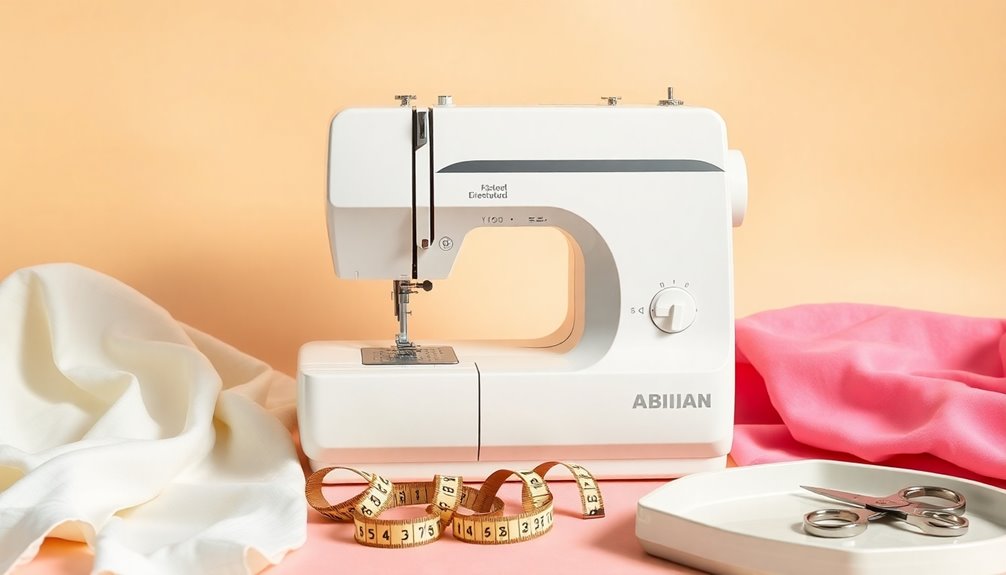
When I think about choosing a serger sewing machine for home finishing, several factors come to mind. It's important to take into account how easy the threading system is, the variety of stitch options available, and the machine's speed and performance. Plus, I always look at fabric compatibility and overall durability to guarantee I'm making a solid investment.
Threading System Ease
Choosing a serger sewing machine for home finishing can feel overwhelming, especially if you're unsure about the threading system. I've found that a color-coded threading system is a game-changer, guiding me through the setup process. It's especially helpful for both beginners and seasoned sewists. Machines with numbered loopers also enhance efficiency, showing the correct order for threading and minimizing errors.
Some models come pre-threaded with sample spools, so I can start sewing right away—a huge time-saver! Additionally, having access to instructional videos can really assist me if I struggle with written guides. Ultimately, ease of threading varies, so I recommend looking for features like automatic threaders that can reduce frustration and streamline the process.
Stitch Options Variety
While exploring serger sewing machines, I quickly realized that having a diverse range of stitch options is essential for achieving professional results. With capabilities for 2, 3, and 4-thread stitches, I can create durable seams and beautifully finished edges. The various stitch types—like overlock, rolled hem, and flatlock—allow me to tackle different projects with ease. Plus, the ability to adjust stitch length and width means I can customize my settings for any fabric, whether it's delicate or heavy. I also appreciate differential feed settings, which help prevent fabric puckering and enable gathering on stretchy materials. Overall, a wider variety of stitch options enhances both my efficiency and creativity in home finishing projects.
Speed and Performance
Understanding the speed and performance of serger sewing machines is essential for anyone looking to elevate their home finishing projects. The maximum sewing speed can range from 1,100 to 1,500 stitches per minute, which means I can tackle large projects efficiently while maintaining high stitch quality. When selecting a machine, I pay attention to features like adjustable differential feed, as it helps me prevent puckering or stretching on various fabrics. Durable cutting blades made from high-quality materials guarantee I get smooth and precise edges, even at high speeds. I've also noticed that some machines handle heavier fabrics better, which greatly impacts my overall satisfaction and productivity. Choosing the right speed and performance features truly makes a difference in my sewing experience.
Fabric Compatibility Range
Having explored speed and performance, I'm now focused on the fabric compatibility range when selecting a serger sewing machine for home finishing. It's essential to take into account the machine's threading capabilities; models with 2/3/4 thread options offer versatility for various fabric types. Adjustable differential feed is another key feature, helping to prevent puckering on lightweight fabrics and accommodating stretchy knits. I always check the maximum sewing speed too; machines that reach up to 1,500 stitches per minute boost efficiency for thicker textiles. A built-in rolled hem feature simplifies shifts between stitching techniques, making delicate fabrics easier to handle. Finally, verify the cutting blade is durable, like one made from carbon steel, for precise edge cutting on multiple layers.
Durability and Construction
When choosing a serger sewing machine for home finishing, I can't emphasize enough the importance of durability and construction. A heavy-duty metal frame is essential, as it enhances stability and minimizes vibrations during operation. I'm always on the lookout for machines with high-quality components, like stainless steel bed plates, which allow fabrics to glide smoothly while boosting longevity. The weight of the machine matters too; heavier models typically deliver better stability and performance, especially with thick fabrics. I also research the internal parts—machines with mostly metal components tend to be more reliable than those made with plastic. Finally, I consider the manufacturer's reputation for quality and customer service, as this greatly influences long-term satisfaction and support for maintenance and repairs.
Included Accessories Package
One key factor I always consider in a serger sewing machine is the included accessories package. A diverse range of presser feet, like standard, blind stitch, and gathering feet, can really enhance the versatility of your projects. I also appreciate an accessory kit that includes essential tools such as tweezers, screwdrivers, and extra needles, making maintenance a breeze. For beginners, having instructional materials like DVDs or guides is invaluable for understanding setup and operation. Additionally, some sergers come with built-in storage compartments, which help keep everything organized and accessible. Finally, specialized feet for techniques like rolled hems or elastic application can greatly expand what you can create, making it a vital consideration for me when selecting a machine.
Maintenance and Support
While choosing a serger sewing machine, I always prioritize maintenance and support options, as they're essential for long-term satisfaction and performance. Regular maintenance is key, like oiling components as the manufacturer recommends to prevent wear and tear. I also look for machines that come with instructional materials, such as DVDs or online tutorials, which make setup and maintenance easier. Keeping a notebook of successful tension settings and stitch adjustments for different fabrics has been invaluable for troubleshooting. Additionally, I consider the availability of customer support and warranty services, as they provide peace of mind for any issues that arise. Finally, I check if specific tools are needed for maintenance tasks, since this can vary in complexity.
Beginner-Friendly Features
Choosing a serger sewing machine with beginner-friendly features makes the journey into home finishing much smoother. I always recommend looking for color-coded threading systems; they simplify setup and eliminate confusion when threading the machine. Additionally, machines with built-in instructional materials, like DVDs or online tutorials, can be invaluable for first-timers, enhancing the learning experience. A user-friendly design, including adjustable differential feed and easy stitch length adjustments, allows beginners to experiment confidently with different fabrics. Lightweight and compact models are great for those with limited space or who need to transport their machines. Finally, opt for sergers that offer a variety of stitch options, giving you the versatility to tackle various projects without feeling overwhelmed.
Frequently Asked Questions
What Is the Difference Between a Serger and a Regular Sewing Machine?
When I first started sewing, I wondered about the difference between a serger and a regular sewing machine. A regular sewing machine's great for straight stitches and basic projects, while a serger specializes in finishing edges and creating professional seams. It uses multiple threads to trim and overlock fabric edges, preventing fraying. So, if you're looking to enhance your sewing game, a serger can really elevate your projects with neat, durable finishes!
Can I Use a Serger for Quilting Projects?
Did you know that around 30% of quilters use sergers for their projects? I love using my serger for quilting because it speeds up the process and gives my edges a professional finish. While it's not a replacement for a regular sewing machine, it's great for piecing and finishing seams. Just keep in mind that you'll need to use it alongside your regular machine for the best results.
How Often Should I Service My Serger Sewing Machine?
I recommend servicing your serger sewing machine at least once a year. Regular maintenance keeps it running smoothly and extends its lifespan. If you sew frequently or notice issues like skipped stitches or unusual noises, it's a good idea to get it checked sooner. I've found that a little upkeep goes a long way in preventing bigger problems down the road. Trust me, your serger will thank you for it!
What Types of Fabrics Work Best With Serger Machines?
Have you ever wondered what fabrics truly shine with a serger? I've found that lightweight knits, like jersey and spandex, work wonders. They glide effortlessly through the machine, creating smooth seams. Cotton blends are also fantastic, offering a sturdy finish. I love experimenting with fleece for cozy projects too. In my experience, the key is to choose fabrics that stretch and move easily, allowing the serger to perform its magic!
Are Serger Machines Suitable for Beginners?
I think serger machines can be great for beginners! They might seem a bit intimidating at first, but once you get the hang of threading and adjusting settings, they make sewing a breeze. I found that they help create neat edges and finish seams quickly, which boosts my confidence. Plus, many sergers come with user-friendly features and tutorials, making it easier to learn. So, don't hesitate to jump in and give it a try!
Conclusion
So, after diving into the world of serger sewing machines, you'd think choosing one would be a breeze, right? Ironically, it's like picking your favorite child—nearly impossible! Each machine has its quirks and strengths, making the decision just as complicated as mastering the art of serging itself. But don't worry, whether you go for the Brother or the JUKI, you'll likely find that perfect seam eventually. Just remember, perfection is overrated anyway!
